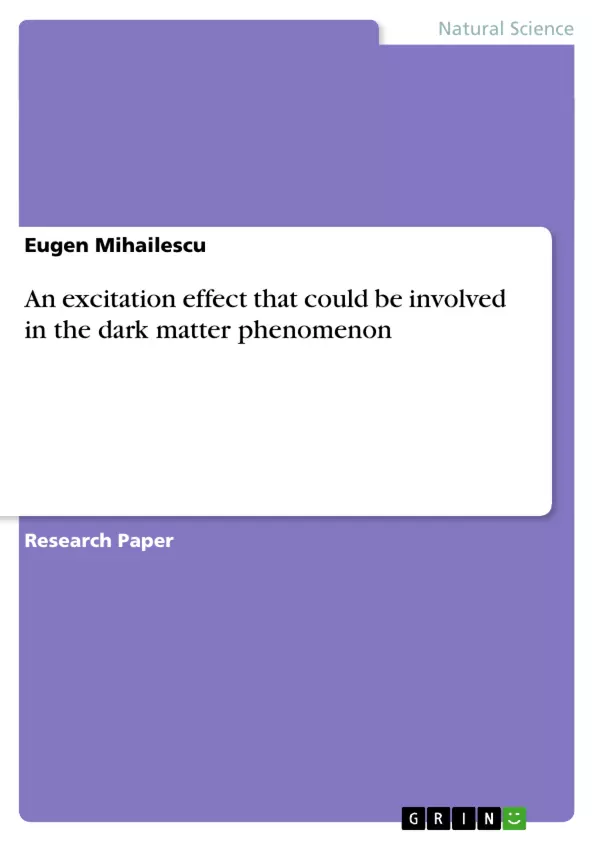The dark matter phenomenon is known since 1933 and it correlates with the
formation and the stability of galaxies and other large-scale structures. In the year 1933 Fritz
Zwicky discovered a stabilization effect connected to the Coma cluster of galaxies [Zwicky,
F. Helv. Phys. Acta 6, 110 – 127 (1933)]. The first interpretation of this stabilization effect
leaded to the hypothesis of dark matter particles that could correlate with a gravitational effect
and that could be involved in the stability of galaxies. Despite the fact that the stability of
galaxies and galaxy clusters is known since more then 70 years, no consistent experimental
data is presently known to support the hypothesis of dark matter particles. The assumed dark
matter particles are presently not yet detected. The main experiment regarding dark matter
particles of the year 2004, respectively the CDMS II experiment [D.S. Akerib et al., Phys.
Rev. Lett. 93, 211301 (2004)] could not confirm the existence of dark matter particles,
respectively of WIMPs (weakly interacting massive particles).
Following an alternative interpretation of the stabilization effect performed by galaxies and
other large-scale structures connected to a boson field, a special excitation effect was found.
This special excitation effect occurs without any presently known form of excitation and it is
detectable in connection with different kind of material samples inside the cavity of a black
body during laboratory experiments as well as during experiments performed outdoors in free
nature. This excitation effect is followed by a regular pattern of emission in the spectral range
of 160 – 630 nm at 273 – 300 K. The regular pattern of emission is uninterrupted detectable
for at least 7 days in connection with samples made of granite and granodiorite.
Inhaltsverzeichnis (Table of Contents)
- Introduction
- An alternative theoretic concept of the dark matter phenomenon
- An overview on the dark matter phenomenon
- An alternative theoretic concept of the dark matter phenomenon based on a boson field
- The both experimental hypotheses of an excitation effect performed by a boson field eventual involved in the dark matter phenomenon
- The experimental basic idea
- The experimental assembly
- The experimental verification of the presented hypotheses
- The exposure of selected material samples to the verified boson field
- Experimental results
- The main findings
- The exposure of material structures to the emission of particles from a force field amplification knot of the verified boson field
- The exposure of selected material samples to the emission of particles from a force field amplification knot of the verified boson field
- Experimental results
- The exposure of the experimental assembly to the emission of particles from a force field amplification knot of the verified boson field
- Experimental results
- The main findings
- The exposure of selected material samples to the emission of particles from a force field amplification knot of the verified boson field
- The exposure of selected material samples to the verified boson field
- Experimental uncertainties
- Discussion
- Backgrounds
- The eventual influence of low level natural radioactivity on the founded UV-VIS emission inside the cavity of the experimental assembly
- Delimitation of the UV-VIS emission inside the cavity of the experimental assembly against thermal radiation and luminescence (phosphorescence, fluorescence, etc.)
- Conclusions
- The next steps
- Acknowledgements
- Literaturverzeichnis / References
Zielsetzung und Themenschwerpunkte (Objectives and Key Themes)
This research work explores the dark matter phenomenon, focusing on an alternative theoretical concept that involves a boson field. The main objective is to investigate a special excitation effect observed in laboratory experiments, which could be linked to dark matter.
- The dark matter phenomenon and its connection to galaxy formation and stability.
- An alternative theoretical concept based on a boson field.
- A special excitation effect observed in connection with various material samples.
- Experimental verification of the proposed hypotheses.
- Discussion of potential uncertainties and limitations.
Zusammenfassung der Kapitel (Chapter Summaries)
The introduction provides background information on the dark matter phenomenon, highlighting the lack of conclusive experimental evidence for its existence. The subsequent chapter proposes an alternative theoretical concept based on a boson field, offering a potential explanation for the stability of galaxies and other large-scale structures. The experimental design and methodology are detailed, outlining the setup for investigating the special excitation effect. Experimental results are presented, analyzing the patterns of emission observed in connection with different material samples. The chapter on experimental uncertainties addresses potential sources of error and limitations of the study. The discussion section elaborates on the findings, considering alternative explanations and the significance of the observed excitation effect. The conclusion summarizes the main findings and outlines future directions for research.
Schlüsselwörter (Keywords)
The research focuses on the dark matter phenomenon, exploring an alternative theoretical concept based on a boson field. The main keywords include dark matter, boson field, excitation effect, UV-VIS emission, experimental verification, and galaxy stability.
- Quote paper
- Eugen Mihailescu (Author), 2005, An excitation effect that could be involved in the dark matter phenomenon, Munich, GRIN Verlag, https://www.grin.com/document/35215



